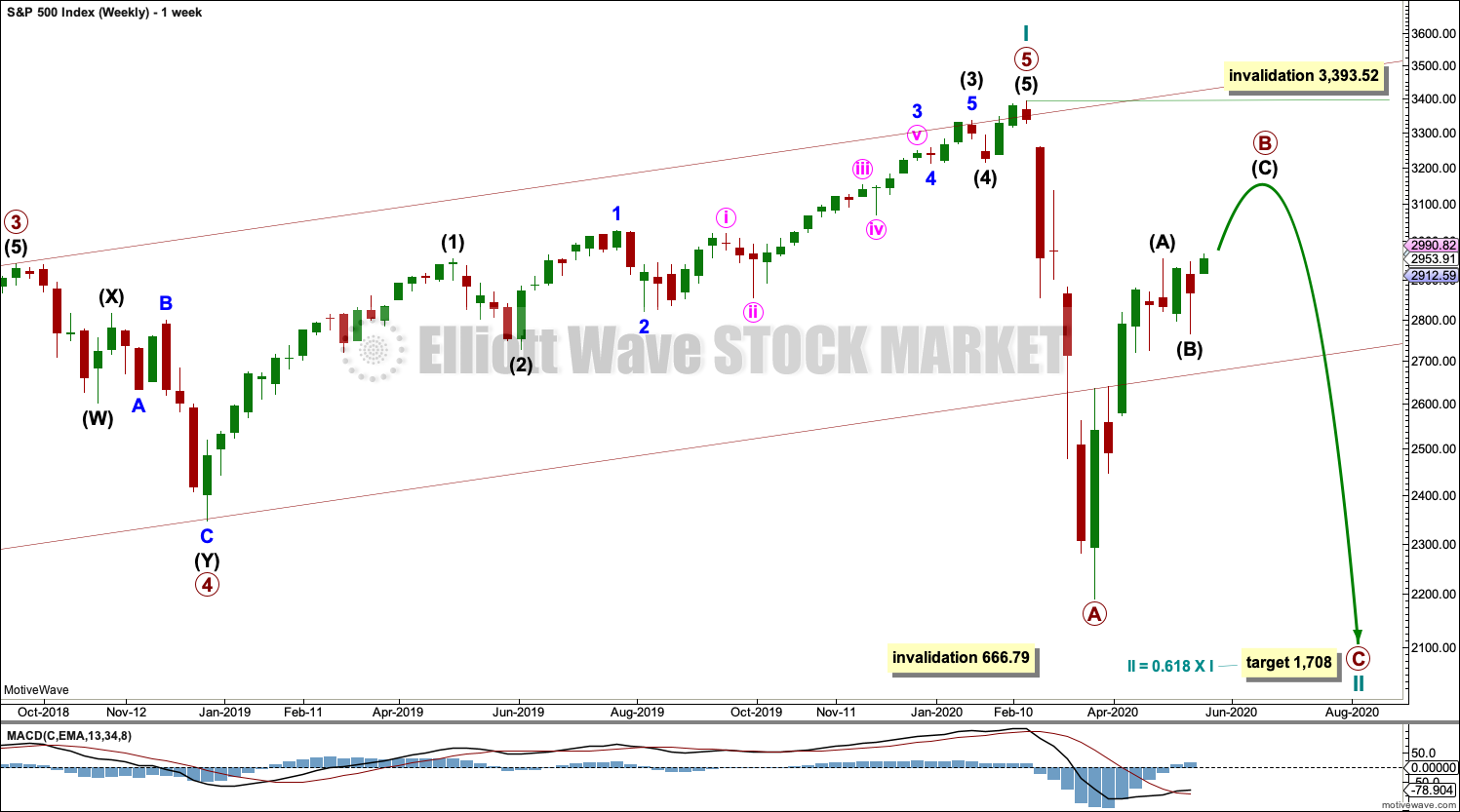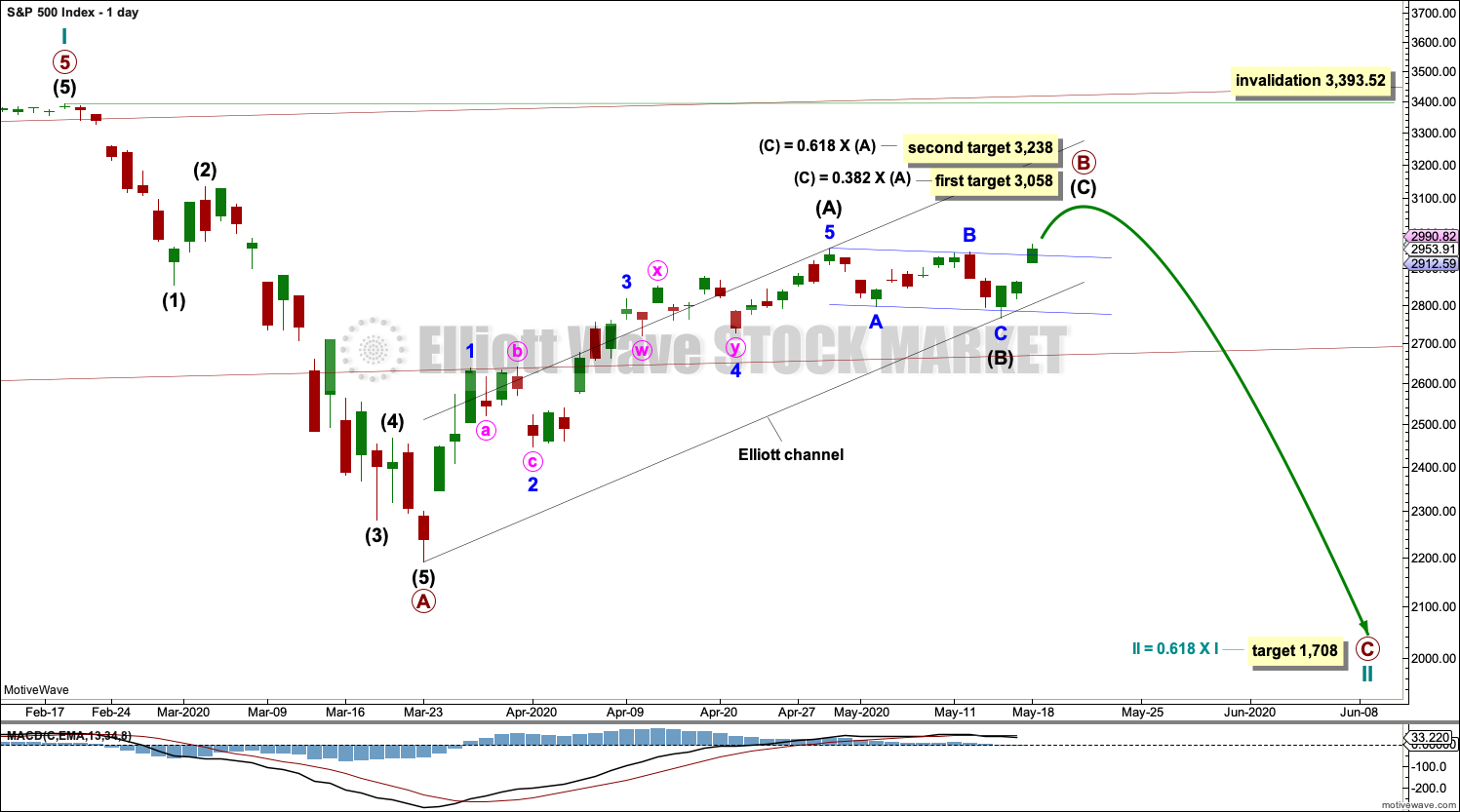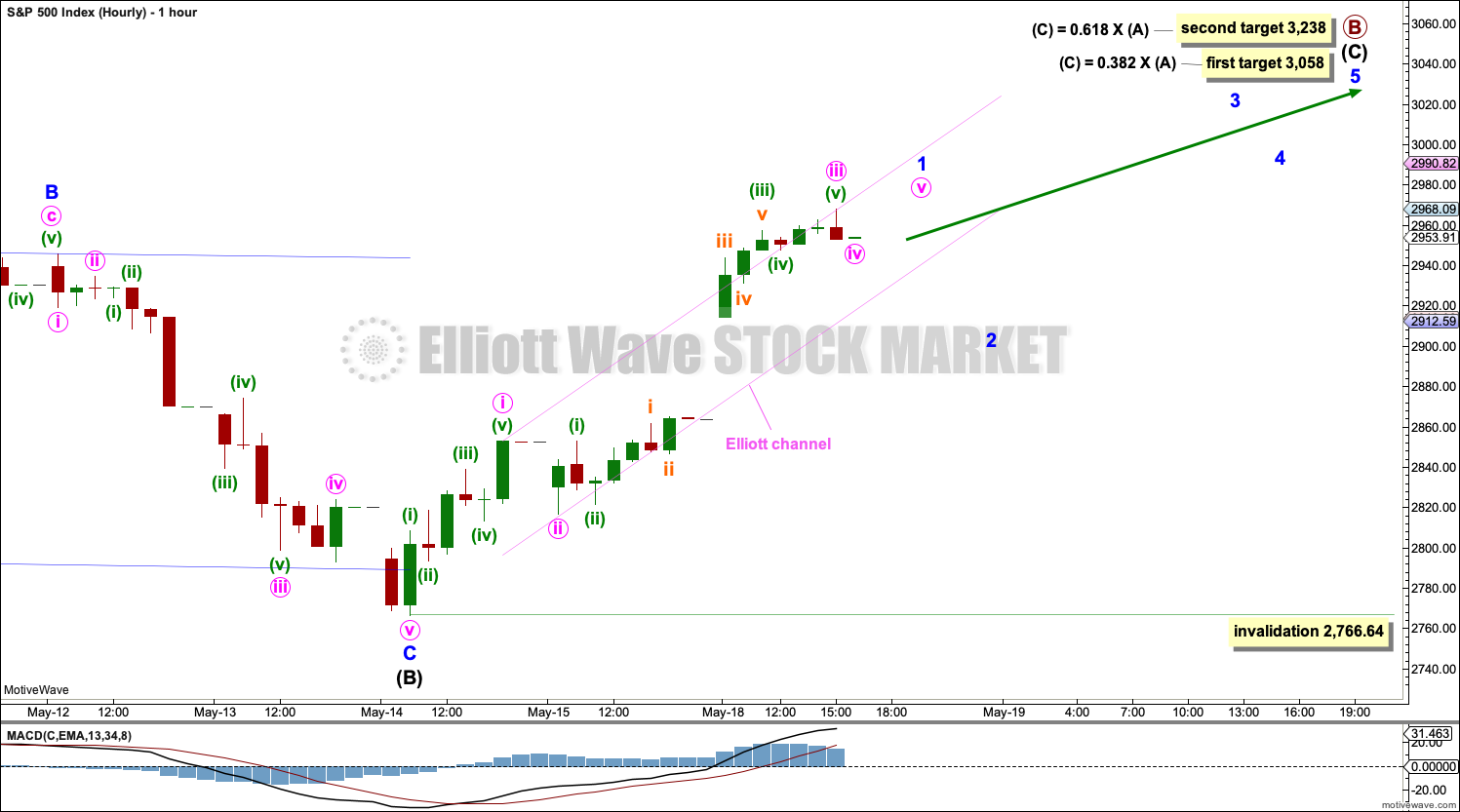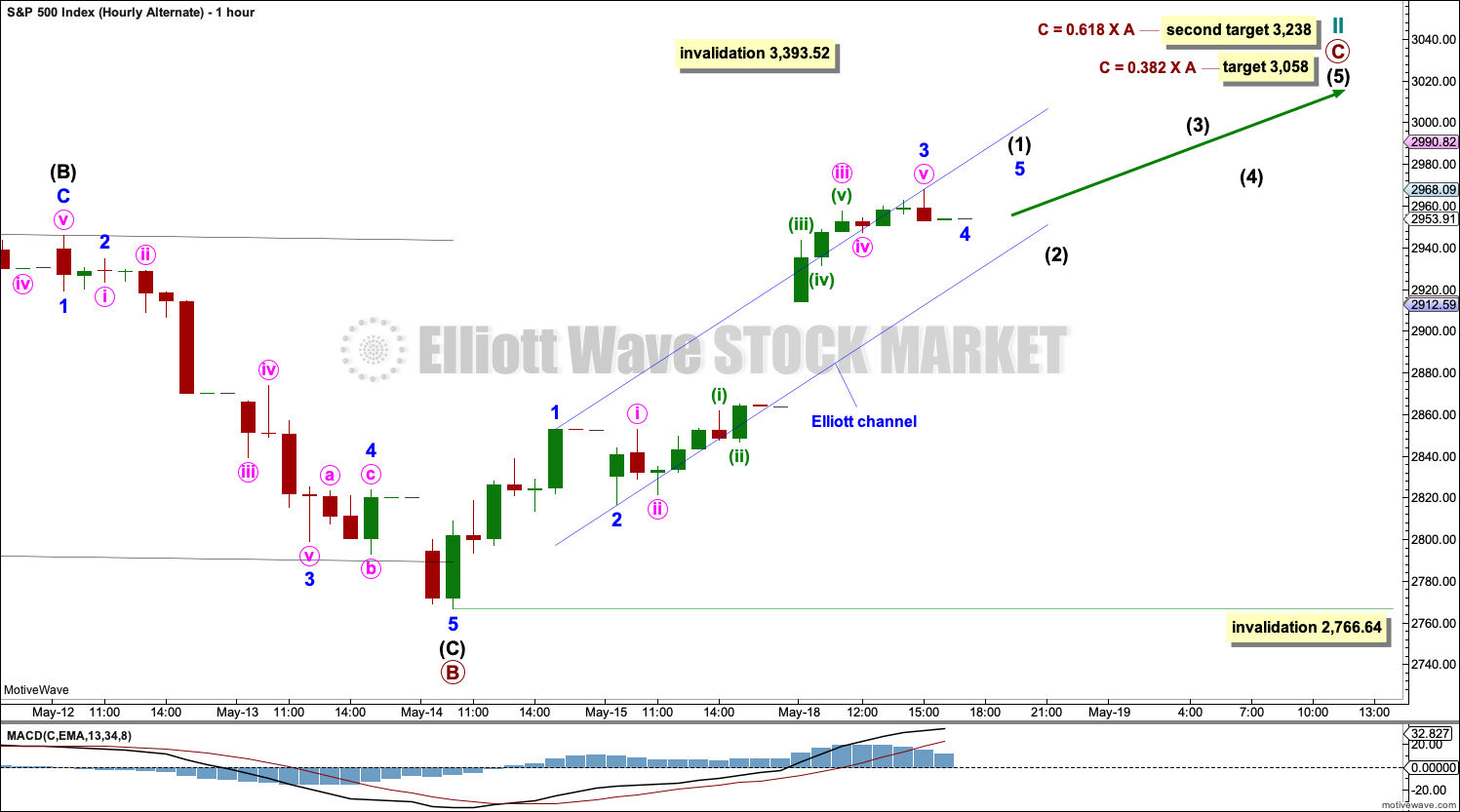S&P 500: Elliott Wave and Technical Analysis | Charts – May 18, 2020
This week was expected to begin with upwards movement, which is exactly what has happened. Two targets remain.
Summary: Targets remain at 3,058 or 3,238 . Use the lower edge of the redrawn Elliott channel to indicate where support may be found on the way up.
This bounce that began on 23rd of March is still expected to be a counter trend bounce within an ongoing bear market. When the bounce is complete, then the bear market is expected to resume with strength.
The biggest picture, Grand Super Cycle analysis, is here.
Last monthly charts are here. Video is here. Members are encouraged to view all three monthly charts. The third is much more bearish than this main wave count and remains a valid possibility.
ELLIOTT WAVE COUNTS
WEEKLY CHART
The channel is now breached by a full weekly candlestick below and not touching the lower edge. Further confidence in this wave count may be had.
Price has reached below the 0.382 Fibonacci ratio of cycle wave I at 2,352 on the last downwards movement. The structure of cycle wave II may need further to go to complete. The next Fibonacci ratio at 0.618 is now a preferred target for cycle wave II to end.
Cycle wave II would most likely subdivide as a zigzag; thus far that looks like what is unfolding. When primary waves A and B may both be complete, then the target may be calculated using a Fibonacci ratio between primary waves A and C. At that stage, the final target may change or widen to a zone.
Cycle wave II may not move beyond the start of cycle wave I below 666.79.
DAILY CHART
Draw the wide maroon trend channel carefully: draw the first trend line from the end of primary wave 1 at 2,093.55 (December 26, 2014), to the end of primary wave 3 at 2,940.91 (September 21, 2018), then place a parallel copy on the end of primary wave 2 at 1,810.10 (February 11, 2016). The channel is fully breached indicating a trend change from the multi-year bull trend to a new bear trend. Resistance at the lower edge has been overcome; price has closed above this trend line.
Cycle wave II may subdivide as any Elliott wave corrective structure except a triangle. It would most likely be a zigzag. Primary wave A may be a complete five wave impulse downwards. Primary wave B may not move beyond the start of primary wave A above 3,393.52.
Draw a channel about intermediate wave (B) using Elliott’s technique for a correction. Draw the first trend line from the start of minor wave A to the end of minor wave B, then place a parallel copy on the end of minor wave A. Minor wave C may have slightly overshot the lower edge of the channel.
Redraw the channel about primary wave B using Elliott’s technique for a correction. Draw the first trend line from the start of intermediate wave A to the end of intermediate wave B, then place a parallel copy on the end of intermediate wave A. Intermediate wave C may find resistance at the upper edge of the channel. While intermediate wave C unfolds higher, any smaller pullbacks within it may find support at the lower edge of this channel.
HOURLY CHART
A flat correction may now be complete for intermediate wave (B), fitting mostly within a parallel channel, with an overshoot at the end.
Intermediate wave (C) may have begun. It may continue for at least a week or two, and possibly up to four weeks.
Intermediate wave (C) must subdivide as a five wave motive structure, either an impulse or an ending diagonal. An impulse is much more likely, so that is what shall be expected unless overlapping suggests a diagonal. Minor wave 2 within intermediate wave (C) may not move beyond the start of minor wave 1 below 2,766.64.
Minor wave 1 may be almost complete. It may complete early during tomorrow’s session. A breach of the upwards sloping pink Elliott channel would be an indication that minor wave 1 may be complete and minor wave 2 may have begun. When the channel is breached by downwards movement, then draw a Fibonacci retracement along the length of minor wave 1 and use the 0.382 and 0.618 Fibonacci ratios as targets for minor wave 2 to end.
SECOND HOURLY CHART
The second wave count is discarded due to the strength of upwards movement in a 90% up day, with support from increased volume, and a bullish signal today from On Balance Volume.
ALTERNATE DAILY CHART
This alternate daily chart follows the Second Alternate Monthly chart published here. Video is here.
By simply moving the degree of labelling in the bull market beginning March 2009 up one degree, it is possible that a Grand Super Cycle trend change occurred on February 19, 2020.
A correction at Grand Super Cycle degree may be expected to last at least a decade, possibly longer. Corrections for this market tend to be much quicker than bullish moves, and so a fair amount of flexibility is required in expectations for duration of the different degrees.
Grand Super Cycle II would most likely subdivide as a zigzag, although it may be any corrective structure except a triangle. It should begin with a five down at the weekly chart time frame, which would be incomplete.
The first wave down on the daily chart is labelled cycle wave I. If this degree of labelling is wrong, it may be too high; it may need to be moved down one degree.
Following cycle wave I, cycle wave II may be continuing higher as a zigzag. Cycle wave II may not move beyond the start of cycle wave I above 3,393.52.
When cycle wave II may again be complete, then a target for cycle wave III may be calculated.
ALTERNATE HOURLY CHART
Cycle wave II may be a continuing higher as a single zigzag. Primary wave B within the zigzag may be complete. Hourly wave counts for the main daily chart work in the same way for this alternate.
TECHNICAL ANALYSIS
WEEKLY CHART
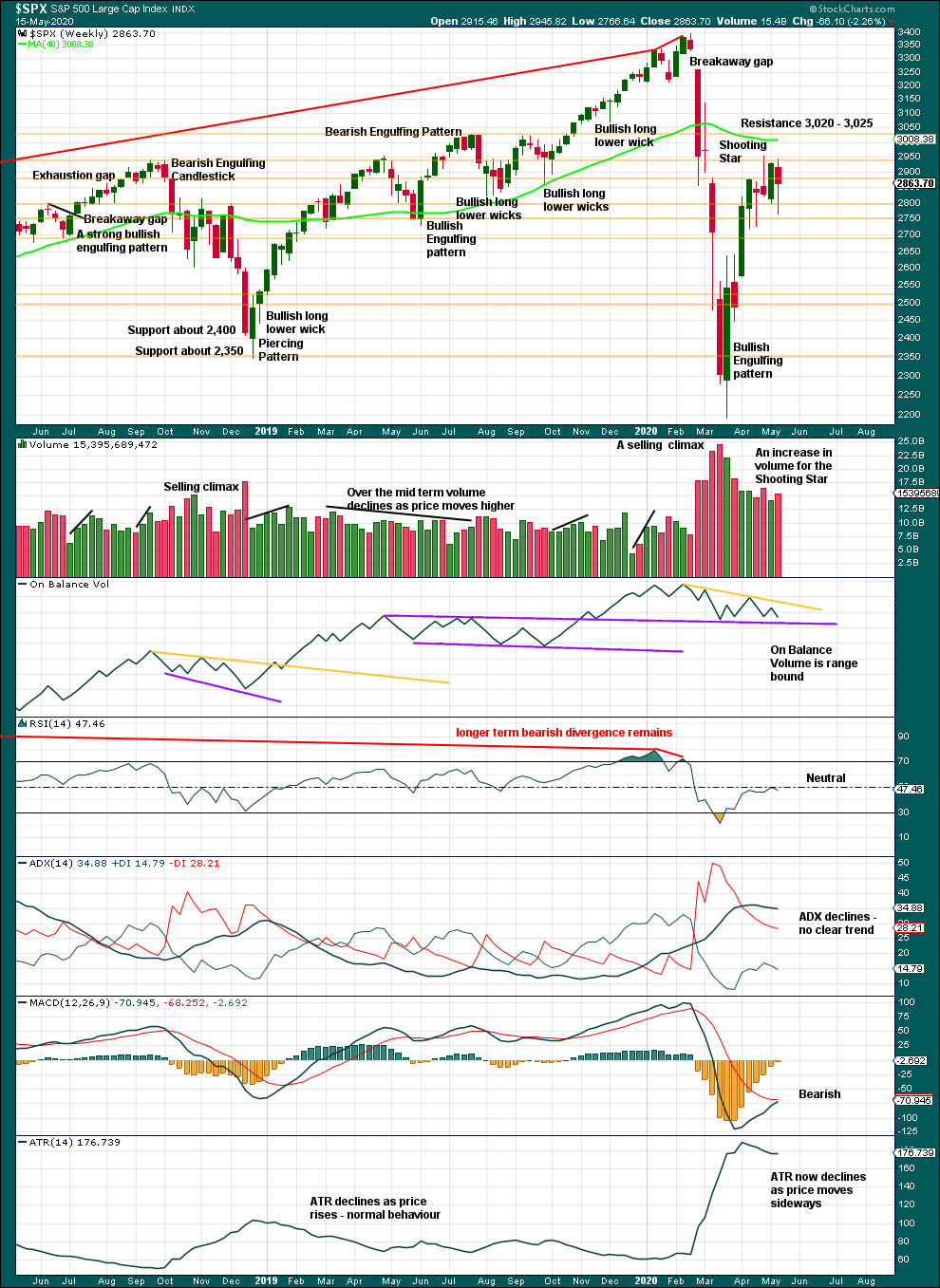
Click chart to enlarge. Chart courtesy of StockCharts.com.
A bullish long lower wick suggests upwards movement this week.
DAILY CHART

Click chart to enlarge. Chart courtesy of StockCharts.com.
In the bear market from October 2000 to March 2009, the first multi-day bounce retraced 0.73 of the first wave down. In the bear market from March 2000 to October 2002, the first multi-day bounce retraced 0.89 of the first wave down. So far this current bounce has retraced 0.65 of the first wave down, so it seems reasonable that it could continue higher.
To see what signals may be looked for to identify a high, the two previous large bear markets were analysed in end of week analysis. The DotCom crash was analysed here with video here. The Global Financial Crisis was also analysed here with video here.
Today price has moved strongly higher but has not quite managed to close above prior resistance, which is taken at 2,954.86 from the high on the 29th of April. However, strength in upwards movement today suggests an upwards breakout may come very soon.
BREADTH – AD LINE
WEEKLY CHART
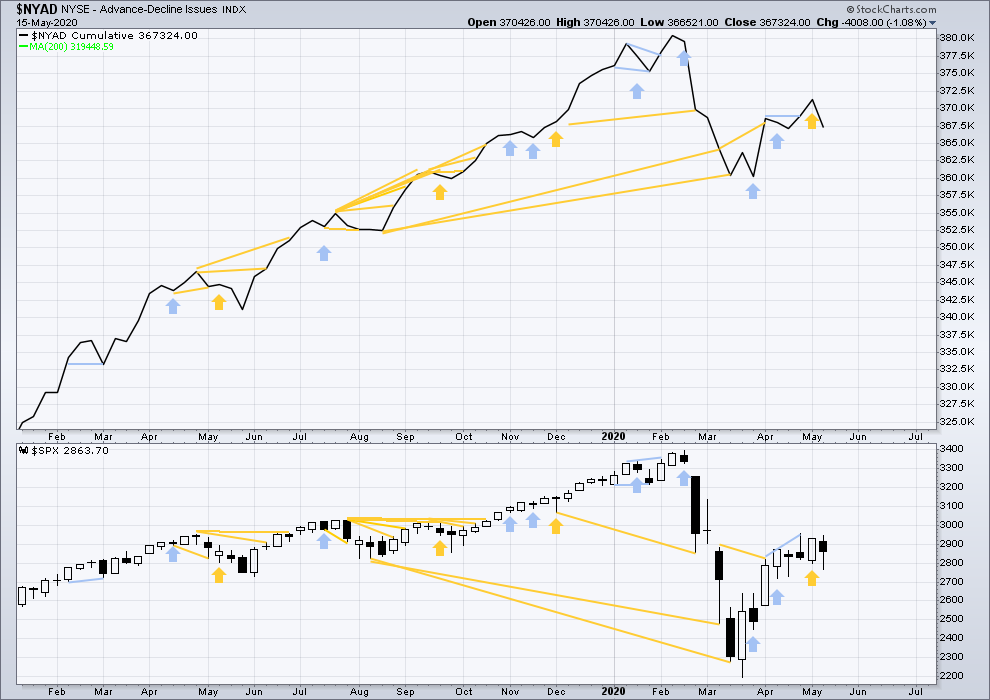
Click chart to enlarge. Chart courtesy of StockCharts.com. So that colour blind members are included, bearish signals will be noted with blue and bullish signals with yellow.
Breadth should be read as a leading indicator.
Last week price completed an outside week, which has closed red. The AD line has declined. There is no new divergence.
Large caps all time high: 3,393.52 on 19th February 2020.
Mid caps all time high: 2,109.43 on 20th February 2020.
Small caps all time high: 1,100.58 on 27th August 2018.
DAILY CHART
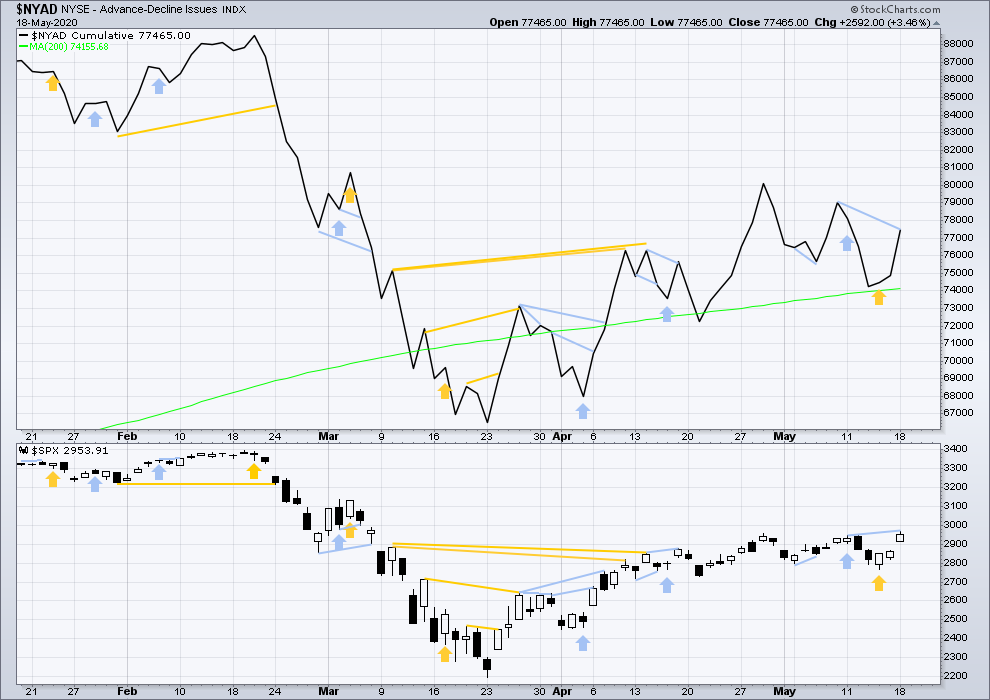
Click chart to enlarge. Chart courtesy of StockCharts.com. So that colour blind members are included, bearish signals will be noted with blue and bullish signals with yellow.
Today both price and the AD line have moved higher. Price has made a slight new high above the prior swing high, but the AD line has not. This divergence is bearish.
VOLATILITY – INVERTED VIX CHART
WEEKLY CHART
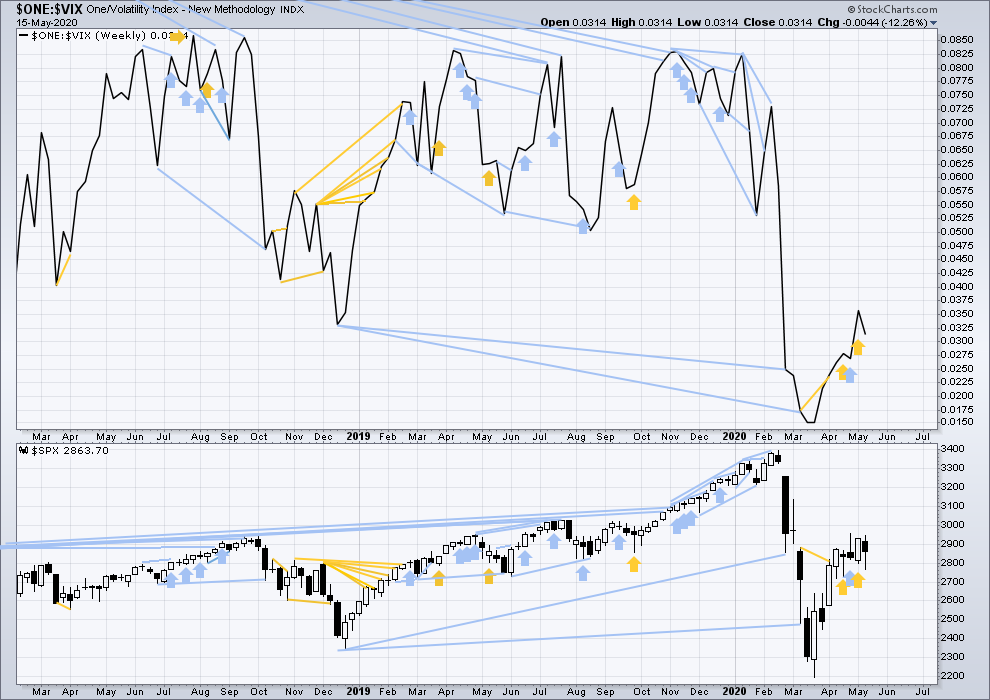
Click chart to enlarge. Chart courtesy of StockCharts.com. So that colour blind members are included, bearish signals will be noted with blue and bullish signals with yellow.
Last week’s bullish divergence has not been followed by upwards movement, so it is considered to have failed. Last week price completed an outside week, which has closed red. Inverted VIX has declined. There is no new divergence.
DAILY CHART
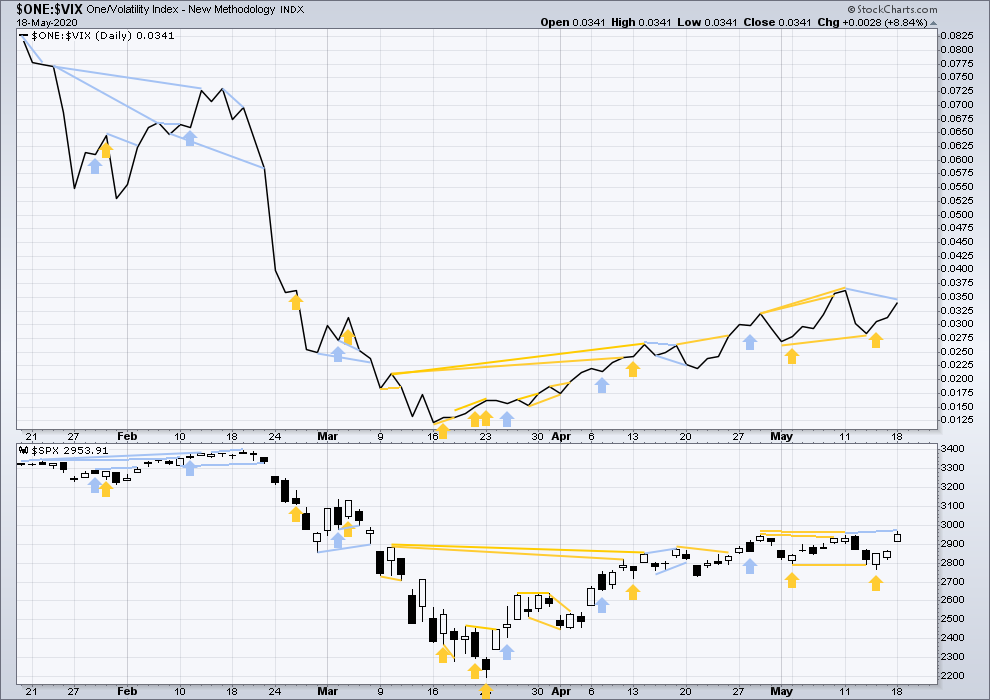
Click chart to enlarge. Chart courtesy of StockCharts.com. So that colour blind members are included, bearish signals will be noted with blue and bullish signals with yellow.
Today both price and inverted VIX have moved higher. Price has made a slight new high above the prior swing high, but inverted VIX has not. This divergence is bearish.
DOW THEORY
Dow Theory has confirmed a bear market with the following lows made on a closing basis:
DJIA: 21,712.53 – a close below this point has been made on the March 12, 2020.
DJT: 8,636.79 – a close below this point has been made on March 9, 2020.
Adding in the S&P and Nasdaq for an extended Dow Theory, a bear market has now been confirmed:
S&P500: 2,346.58 – a close below this point has now been made on March 20, 2020.
Nasdaq: 7,292.22 – a close below this point was made on the March 12, 2020.
Published @ 06:40 p.m. EST.
—
Careful risk management protects your trading account(s).
Follow my two Golden Rules:
1. Always trade with stops.
2. Risk only 1-5% of equity on any one trade.
—
New updates to this analysis are in bold.

